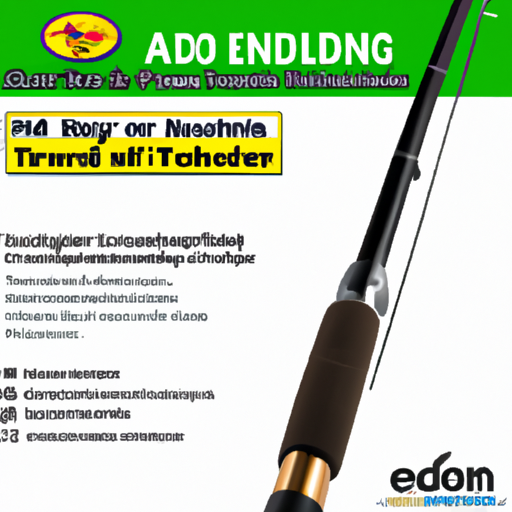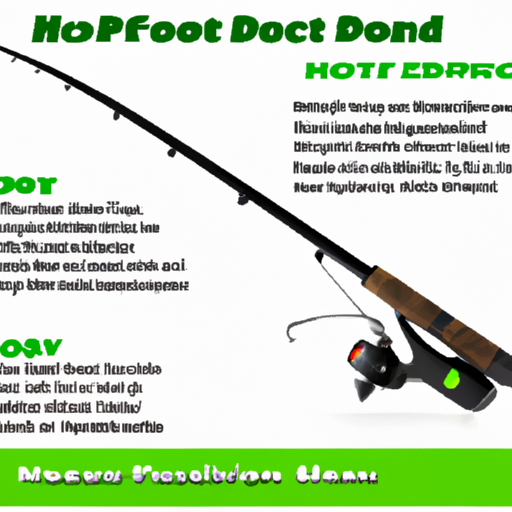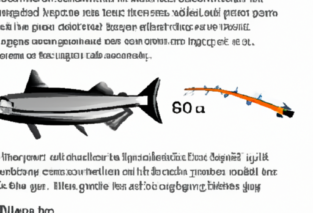Are you a beginner in the world of fishing? If so, then understanding the significance of fishing rod action and power is essential for your journey into this exciting hobby. In this article, we will explore the importance of these two factors and how they can greatly impact your fishing experience. Whether you’re casting for the first time or looking to enhance your skills, gaining knowledge about fishing rod action and power will empower you to make informed decisions and improve your chances of landing that big catch. Let’s dive in and discover the world of fishing rod action and power together!

Understanding Fishing Rod Action
What is fishing rod action?
Fishing rod action refers to the degree of flexibility or stiffness in the upper two-thirds of the fishing rod, specifically the tip. It determines how much the rod will flex when pressure is applied, such as when casting a line or reeling in a fish. The action of a fishing rod is classified into three main categories: slow, medium, and fast. Each category offers distinct advantages and disadvantages, depending on the angler’s needs and preferences.
Different types of fishing rod actions
- Slow Action: A slow-action fishing rod will flex significantly along its entire length, including the butt section. This action allows for a more delicate presentation, making it ideal for light tackle and finesse fishing techniques. Slow-action rods are also well-suited for fighting smaller fish, as they provide more give and prevent the line from breaking easily.
- Medium Action: Medium-action fishing rods are the most versatile and popular choice among anglers. They provide a balance between flexibility and stiffness, allowing for casting accuracy and the ability to handle a wide range of fishing situations. Medium-action rods are suitable for various fishing techniques, such as freshwater fishing, bass fishing, and trolling.
- Fast Action: Fast-action fishing rods have a stiff tip that only flexes towards the upper third of the rod. This action is preferred by experienced anglers who require greater casting distance and sensitivity. Fast-action rods provide a quick hookset and are commonly used for fishing in saltwater, when targeting larger species, or when using heavy lures or baits.
Choosing the right fishing rod action for beginners
For beginners, it is generally recommended to start with a medium-action fishing rod. This action strikes a balance between sensitivity and ease of use, making it suitable for a wide range of fishing applications. Medium-action rods are forgiving and provide a good learning experience for beginners who are still mastering their casting and reeling techniques. As beginners gain more experience and define their preferred fishing style, they can then experiment with different rod actions to suit their specific needs.
Determining Fishing Rod Power
What is fishing rod power?
Fishing rod power refers to the rod’s ability to handle different amounts of pressure or weight, such as when casting a heavy lure or fighting a powerful fish. Power is categorized into various classifications, ranging from ultra-light to heavy, and is closely related to the rod’s strength and flexibility. It is an essential factor to consider when selecting a fishing rod, as it determines the rod’s overall performance and suitability for specific fishing conditions.
Different fishing rod power classifications
- Ultra-Light: Ultra-light power rods are designed for light fishing applications, such as targeting small panfish or trout in freshwater. They have a delicate structure and can handle very light line and lures. Ultra-light rods are less powerful but offer increased sensitivity, making them ideal for finesse fishing techniques.
- Light: Light power rods provide slightly more strength and can handle slightly heavier lures and lines. They are commonly used for freshwater fishing for species like bass, walleye, and trout.
- Medium: Medium power rods are versatile and suitable for a wide range of fishing techniques and species. They offer a good balance between sensitivity and strength, making them a popular choice among anglers. Medium power rods are commonly used for freshwater fishing, inshore saltwater fishing, and trolling.
- Medium-Heavy and Heavy: These power ratings are designed for heavier applications, such as fishing for larger freshwater species like musky or saltwater fishing for larger game fish like marlin or tuna. They can handle heavier lines, lures, and can handle the stress of fighting larger, more aggressive fish.
Considerations for selecting the appropriate fishing rod power
When selecting a fishing rod power, several factors need to be considered:
- The target species: Consider the average size and fighting abilities of the fish you intend to catch. A light power rod may not be adequate for targeting larger, stronger species.
- Fishing technique: Different fishing techniques require different power ratings. For example, heavy lures or deep-sea fishing may require a heavier power rating.
- Fishing environment: Consider the conditions in which you’ll be fishing, such as strong currents or heavy cover. These factors can affect the amount of pressure applied to the rod and may require a more powerful rod.

Effect of Fishing Rod Action on Casting Distance
How fishing rod action affects casting distance
The action of a fishing rod directly influences casting distance. A fast-action rod, with its stiff tip, allows for greater transfer of energy, resulting in longer casting distances. On the other hand, a slow-action rod, with its more flexible nature, does not generate as much power and can limit the casting distance. Medium-action rods offer a balance between the two, providing an adequate amount of casting power without sacrificing sensitivity.
Action recommendations based on casting distance needs
- Long Casting: If long casting distances are a priority, a fast-action fishing rod is recommended. The stiff tip will generate greater rod loading and release the energy efficiently, resulting in longer casts.
- Moderate Casting: For most angling situations, a medium-action rod is appropriate. It offers a good balance between sensitivity and casting distance, making it suitable for various fishing techniques and conditions.
- Short Casting: In situations where precision and accuracy are more important than distance, a slow-action rod may be more suitable. The increased flexibility allows for more controlled and delicate presentations.
Balancing action and power for optimal casting performance
It is important to consider not only the fishing rod’s action but also its power when looking for optimal casting performance. The action determines the casting distance, while the power determines the rod’s ability to handle the weight of the lure. By matching the appropriate action and power, anglers can achieve maximum casting performance and accuracy. Experimenting with different combinations and seeking advice from experienced anglers can help fine-tune the setup to individual preferences and fishing conditions.
Impact of Fishing Rod Power on Lure Weight Capacity
Understanding the correlation between power and lure weight capacity
The power of a fishing rod directly impacts its ability to handle different lure weights. A rod with a lighter power rating may have a lower lure weight capacity, meaning it may not be able to cast or handle heavier lures as effectively. Conversely, a rod with a heavier power rating can handle heavier lures with ease. Understanding the correlation between power and lure weight capacity is essential for selecting the right rod for specific fishing techniques and target species.
Choosing the right fishing rod power for specific lure weights
When selecting a fishing rod, consider the average lure weight you plan to use. Match the lure weight to the rod’s power rating by checking the manufacturer’s specifications or consulting experienced anglers or tackle shops for recommendations. It is crucial to choose a rod with the appropriate power rating to avoid damaging the rod or compromising its performance. Using a rod with insufficient power may result in poor casting distance, control, or even breakage, while using a rod with excessive power may impede the action of the lure and decrease sensitivity.
Avoiding damage or reduced efficiency by matching power to lure weight
It is important to match the fishing rod power to the recommended lure weight range to avoid potential issues. Using a lure that is too heavy for the rod’s power rating can put excessive strain on the rod and increase the risk of damage, such as broken guides or even a broken rod. On the other hand, using a lure that is too light for the rod’s power rating can result in reduced efficiency, as the rod may not load properly and transfer enough energy to generate an effective cast. By considering the power and lure weight relationship, anglers can optimize their equipment’s performance and prolong its lifespan.

Sensitivity and Fishing Rod Action
Exploring the relationship between sensitivity and fishing rod action
Sensitivity is an important factor in fishing, as it allows anglers to detect subtle movements or bites from fish. The fishing rod’s action plays a crucial role in determining its sensitivity. Fast-action rods, with their stiff tips, are generally less sensitive to subtle movements but excel in transmitting information about more significant actions, such as fish strikes. In contrast, slow-action rods, with their increased flexibility, excel in detecting even the slightest movements or gentle tugs.
How action influences sensitivity to fish bites
When targeting species known for light and delicate bites, such as trout or panfish, a slow-action fishing rod can enhance sensitivity. The increased flexibility allows the angler to detect even the faintest of bites, resulting in better hook-set rates. However, when targeting species with aggressive biting habits or fishing in conditions where quick hook-sets are crucial, such as saltwater fishing, a fast-action rod may be more suitable. The stiff tip of a fast-action rod ensures a quick response and minimizes the risk of missed strikes.
Selecting the ideal rod action for improved sensitivity
Selecting the ideal rod action for improved sensitivity depends on the fishing technique, target species, and personal preference. For finesse fishing techniques or situations where bites can be very subtle, a slower-action rod is recommended. Anglers who prefer a more immediate response or require increased hook-setting power may opt for a fast-action rod. It is important to consider the specific fishing scenario and adapt the rod action accordingly to achieve optimal sensitivity and improve overall fishing success.
Strength and Flexibility in Fishing Rod Power
The role of power in rod strength and flexibility
Fishing rod power directly influences its strength and flexibility. Lighter power ratings offer increased flexibility and sensitivity, while heavier power ratings provide more strength and less flexibility. Understanding these characteristics allows anglers to select the appropriate rod power for their preferred fishing techniques and target species.
Advantages and disadvantages of different power ratings
- Light Power: Light power rods offer increased flexibility and sensitivity, making them ideal for finesse fishing techniques and targeting smaller fish species. However, they may lack the strength required to handle larger, more aggressive fish.
- Medium Power: Medium power rods strike a balance between flexibility and strength. They are versatile and suitable for a wide range of fishing techniques and species. Medium power rods provide enough sensitivity to detect bites while offering enough strength to handle larger fish.
- Heavy Power: Heavy power rods are designed for fishing situations that require increased strength and durability. They excel in handling heavy lures, larger fish, or fishing in challenging conditions. However, heavy power rods may sacrifice some sensitivity and finesse compared to lighter power ratings.
Considering species, target conditions, and personal preference when choosing rod power
When selecting fishing rod power, it is important to consider the target species, fishing conditions, and personal preference. Different species have varying sizes and fighting abilities, and selecting an appropriate power rating ensures the angler can handle the fish effectively. Fishing conditions, such as strong currents or heavy cover, may require a heavier power rating for increased control. Personal preference plays a vital role, as anglers may have different preferences when it comes to the feel and performance of the fishing rod. It is recommended to seek advice from experienced anglers or visit a tackle shop to receive guidance specific to individual fishing preferences and target species.

Casting Techniques and Fishing Rod Action
How fishing rod action affects different casting techniques
The action of a fishing rod plays a crucial role in the performance and effectiveness of various casting techniques. Different actions provide different benefits depending on the desired casting outcome. Understanding how fishing rod action affects different casting techniques allows anglers to fine-tune their approach for optimal results.
Action recommendations for various casting methods
- Overhead Cast: For overhead casting, a fast-action rod is generally recommended. The stiff tip provides the necessary power to generate long and accurate casts, allowing for precise lure placement. This action is particularly useful in situations where distance and accuracy are key.
- Sidearm Cast: A medium-action rod is often suitable for sidearm casting. The moderate action allows for sufficient power and flexibility, enabling anglers to make accurate casts while maintaining control. Sidearm casting is often used when fishing in tight spots or when a low-profile cast is required.
- Roll Cast: Roll casting typically requires a slower-action rod that enables proper load and energy release. The increased flexibility of a slow-action rod allows anglers to execute roll casts efficiently, making it suitable for situations where backcasting space is limited or when delicate presentations are desired.
Fine-tuning action for specific fishing styles
Fine-tuning the fishing rod action for specific fishing styles is essential for optimizing performance and achieving desired results. Anglers can experiment with different rod actions to find the one that suits their preferred fishing style and target species. Factors such as casting distance, accuracy, sensitivity, and lure presentation can all be influenced by the rod action. By understanding the requirements of each fishing style and selecting the appropriate rod action, anglers can enhance their overall fishing experience and success.
Landing and Fighting Fish with Fishing Rod Power
Understanding the influence of rod power when landing fish
The power of a fishing rod significantly influences the angler’s ability to land and control a fish. Landing fish requires the rod to have enough strength to handle the fish’s weight, strength, and pulling capabilities. Having the appropriate rod power ensures that the angler can effectively fight the fish and bring it closer to shore or into the boat without overstressing the rod or risking a potential breakage.
Matching rod power to target fish size and fighting abilities
When landing fish, anglers should select a rod power that matches the target fish’s size and fighting abilities. For smaller fish species or those with less fighting power, such as panfish or trout, a light or medium power rod is often sufficient. However, when targeting larger and more aggressive fish species, such as bass or saltwater species, a heavier power rod is recommended. The increased strength and durability of a heavier power rod provide the angler with more control during the fight, reducing the risk of the fish breaking off.
Tips for handling stronger fish with different power ratings
When dealing with stronger fish, regardless of the rod power rating, there are several tips to consider:
- Maintain steady pressure: Apply consistent pressure to tire out the fish rather than trying to overpower it. This allows the angler to control the fight and prevent the fish from making sudden runs or jumps that could lead to a broken line or rod.
- Keep the rod at a proper angle: Maintain an angle that applies pressure to the fish without stressing the rod excessively. Holding the rod too vertically can put excessive strain on the rod, while holding it too horizontally can reduce the angler’s ability to control the fish.
- Use the rod’s parabolic bend: Allow the rod to bend and act as a shock absorber to absorb the fish’s sudden movements. This provides a buffer that prevents line breakage or rod failure.
- Use a proper drag setting: Set the reel’s drag to a suitable tension that allows the fish to take some line while maintaining control. Adjust the drag as needed during the fight to accommodate the fish’s strength and sudden movements. By following these tips and considering the appropriate rod power for the target fish, anglers can increase their chances of successfully landing even the strongest and most challenging fish species.

Fishing Rod Action and Power: Maintenance and Care
General maintenance tips for fishing rods
Proper maintenance and care can help ensure the longevity and optimal performance of fishing rods, regardless of their action or power rating. Some general maintenance tips include:
- Rinse with freshwater: After each fishing trip, rinse the rod with freshwater to remove any salt, sand, or dirt that may accumulate. Pay special attention to the reel seat, guides, and handle.
- Check for damage: Regularly inspect the rod for any signs of wear, such as loose or cracked guides, loose reel seats, or damaged sections. Promptly repair or replace any damaged parts to prevent further issues.
- Store properly: Store the fishing rod in a rod tube or rod sock when not in use, protecting it from accidental damage or exposure to extreme temperatures. Avoid storing the rod horizontally, as this can cause undue stress on the guides.
- Avoid high impacts: Handle the fishing rod with care and avoid subjecting it to high impacts, such as dropping it on hard surfaces or slamming it against objects. Such impacts can weaken the rod’s structure and compromise its overall performance.
Action and power-specific care considerations
While general maintenance applies to all fishing rods, certain care considerations may be specific to the rod’s action or power:
- Slow-action rods: The increased flexibility of a slow-action rod requires extra care to prevent excessive stress. Avoid applying excessive force or sudden jerks, as this can lead to rod breakage. Exercise caution when fighting larger, stronger fish that may exert more force on the rod.
- Fast-action rods: The stiffness of a fast-action rod provides durability and strength, but it is still important to avoid high impacts or excessive pressure. When landing fish, maintain a smooth and steady pressure rather than trying to overpower the fish abruptly, as this can lead to rod failure.
- Light power rods: Light power rods are more delicate and require gentle handling. Avoid overloading the rod with heavy lures or attempting to overpower fish beyond its recommended weight capacity. Be cautious when landing larger fish, as excessive force can result in the rod snapping under the pressure.
- Heavy power rods: While heavy power rods are designed for increased strength and durability, it is still important to avoid applying excessive or unnecessary force. Maintain control during the fight and avoid high-impact situations that can compromise the rod’s integrity.
By following these maintenance and care tips and considering the unique needs of each rod’s action and power rating, anglers can prolong the lifespan of their fishing rods and preserve their optimal performance.
Seeking Assistance and Expertise
Importance of seeking advice from experienced anglers or tackle shops
For beginners or those seeking to improve their understanding of fishing rod action and power, seeking advice from experienced anglers or visiting tackle shops can be invaluable. These sources provide firsthand knowledge and expertise that can guide anglers in selecting the right fishing rod for their specific needs, fishing style, and target species. Experienced anglers can offer valuable insights based on their own experiences, while tackle shops often have knowledgeable staff members who can provide recommendations tailored to individual requirements.
Utilizing resources to gather information on rod action and power
Aside from seeking advice, anglers can utilize various resources to gather information on fishing rod action and power. Websites, fishing forums, books, and fishing magazines often contain articles and guides that explain the different aspects of fishing rod action and power. Online videos and tutorials can also provide visual demonstrations and insights into selecting the right rod for specific fishing techniques or conditions. By leveraging these resources, anglers can expand their knowledge and make informed decisions when purchasing a fishing rod.
Understanding the personal aspect of rod selection and learning from others
While expert advice and informational resources are valuable, it is essential for anglers to consider their own preferences and fishing style when selecting a fishing rod. Ultimately, the right rod choice is a personal one that depends on the angler’s individual needs and comfort. Learning from others, whether through shared experiences, observations, or discussions, can provide valuable insights and perspectives that can aid in forming one’s preferences. Different anglers may have varied opinions on rod action and power based on their personal fishing experiences, and by engaging in discussions and sharing knowledge, anglers can enhance their understanding of fishing rods and refine their selections for optimal performance.
In conclusion, understanding fishing rod action and power is crucial for anglers, particularly beginners, as it directly impacts casting performance, sensitivity, lure weight capacity, and the ability to land fish effectively. By comprehending the different types of fishing rod actions and power classifications, anglers can make informed decisions when selecting a fishing rod that aligns with their fishing techniques, target species, and personal preferences. Additionally, proper maintenance and care, along with seeking advice and resources, contribute to maintaining the longevity and optimal performance of fishing rods. Embracing the personal aspect of rod selection and learning from others further enhances the angler’s knowledge and ensures a rewarding and successful fishing experience.





